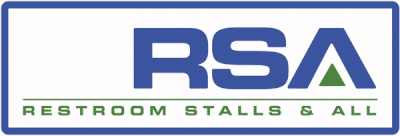Restroom Stall Dimensions: Standard and ADA Handicap Stalls
Posted by Restroom Stalls and All on Mar 24th 2021
If you’re involved in any commercial bathroom design, upgrade, or remodel, one of the most important considerations will be the dimensions of stalls. While the overall toilet room size may vary depending on your available space, bathroom partitions and restroom stall doors follow certain standard dimensions and must often comply with building codes. These standards are designed to ensure safety, comfort, accessibility, and functionality for all users, including people with disabilities.
At Restroom Stalls and All, we provide everything you need to complete these projects—ranging from stall dividers and partitions to restroom accessories such as changing stations, dispensers, hardware, partition door, and more. In this two-part guide, we’ll cover the essentials of measuring bathroom stalls, the standards that regulate them, and the clearances required for compliant and comfortable restroom design.

ADA Standards
The most widely recognized guidelines come from the Americans with Disabilities Act (ADA). While the ADA only legally mandates dimensions for toilet stalls designed for wheelchair access, many of its principles can be applied throughout the bathroom.
For example, wheelchair space must be carefully planned, ensuring minimum clearance around fixtures, as well as proper side wall positioning for support bars and gripping surfaces. The ADA also specifies seat heights, door widths, and the shaped space required for maneuvering mobility devices. Even when not legally required, these standards provide a reliable baseline for creating a safe, inclusive, and user-friendly restroom.
Standard Dimensions
In non-ADA stalls, the following measurements are typical in commercial restrooms:
-
Restroom stall door: 24 inches wide, 58 inches high
-
Toilet stall: 36 inches wide by 60 inches deep
That said, stall depth can vary significantly—anywhere from 48 to 78 inches—depending on the bathroom layout. Depth is especially important when considering the clearances required for inward-swinging doors, which must open fully without obstructing the toilet.
By adhering to these dimensions, designers ensure both compliance with building codes and the comfort and privacy of bathroom users.
Handicap Stall Requirements
Where the ADA does become legally binding is in the construction of handicap stalls. Every public restroom must include at least one compliant stall with:
-
A door at least 36 inches wide
-
An interior space at least 60 inches wide and 60 inches deep
-
Adequate minimum clearance for wheelchair maneuverability
-
An outward-swinging door for added interior space
-
Proper placement of gripping surfaces and grab bars along the side wall
Many ADA-compliant stalls are also built at the end of a row, often exceeding 100 inches in width to maximize accessibility. This ensures the necessary space for wheelchair users while maintaining comfort for all.
Final Thoughts
Designing or remodeling a restroom isn’t just about aesthetics—it’s about meeting building codes, ensuring proper clearances, and creating functional spaces that serve everyone. From bathroom partitions and stall doors to precise seat heights and accessible layouts, these details make a major difference.
For expert guidance on restroom stall dimensions or to learn more about our wide range of bathroom partitions, toilet stalls, and restroom accessories, contact the team at Restroom Stalls and All today.


